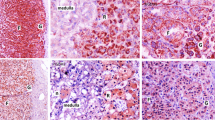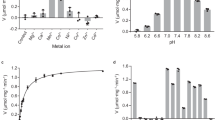Abstract
l-lactate dehydrogenase is a crucial enzyme in the process of glycolysis. Here we report the cloning and characterization of another novel lactate dehydrogenase gene, named as LDHAL6A (lactate dehydrogenase A-like 6A), which encodes a 332-amino-acid protein. The LDHAL6A gene consists of seven exons, and is mapped to 11p15.1 by searching the UCSC genomic database. By RT-PCR analysis in various tissues, LDHAL6A was found to be exclusively expressed in human testis. Subcellular localization demonstrated that LDHAL6A protein was located in the cytoplasm when overexpressed in COS7 cells. Furthermore, we found that the recombinant protein GST-LDHAL6A can catalyze the pyruvate convert into the lactate with NADH as its coenzyme. And in the dual luciferase reporter system, expression of LDHAL6A was able to activate transcriptional activities of AP1(PMA).






Similar content being viewed by others
Abbreviations
- LDH:
-
l-lactate dehydrogenase
- LDHAL6A:
-
Lactate dehydrogenase A-like 6A
- NAD+:
-
Nicotinamide adenine dinucleotide
References
Goldberg E (1963) Lactic and malic dehydrogenases in human spermatozoa. Science 139:602–603
Goldberg E, Hawtrey C (1967) The ontogeny of sperm specific lactate dehydrogenase in mice. J Exp Zool 164:309–316
Hawtrey J, Goldberg E (1970) Some kinetic aspects of sperm specific lactate dehydrogenase in mice. J Exp Zool 174:451–462
Venables JP (2002) Alternative splicing in the testes. Curr Opin Genet Dev 12:615–619
Eddy EM, O’Brien DA (1998) Gene expression during mammalian meiosis. Curr Top Dev Biol 37:141–200
Goldberg E (1996) Transcriptional regulatory strategies in male germ cells. J Androl 17:628–632
Wang H, Zhou ZM, Lu L, Xu ZY, Sha JH (2005) Cloning and characterization of a novel intronless lactate dehydrogenase gene in human testis. J Mol Med 15:949–953
Kramer JA, MeCarrey JR, Djakiew D, Krawetz SA (2000) Human spermatogenesis as a model to examine gene potentiation. Mol Reprod Dev 56:S254–S258
Escalier D (2001) Impact of genetic engineering on the understanding of spermatogenesis. Hum Reprod Update 7:191–210
Tang WW, Yuan J, Chen XY, Shan YX, Luo KT, Guo ZK, Zhang Y, Wan B, Yu L (2005) Cloning and characterization of the CDZFP gene which encodes a putative zinc finger protein. DNA Seq 16(5):391–396
Kramer JA (2001) Omiga: a PC-based sequence analysis tool. Mol Biotechnol 19:97–106
Kent WJ (2002) BLAT—the BLAST-like alignment tool. Genome Res 12:656–664
Zinkham WH, Blanco A, Kupchyk L (1963) Lactate dehydrogenase in testis: dissociation and recombination of subunits. Science 142:1303–1304
Thomas K, Del Mazo J, Eversole P, Bellve A, Hiraoka Y, Li SS, Simon M (1990) Developmental regulation of expression of the lactate dehydrogenase (LDH) multigene family during mouse spermatogenesis. Development 109:483–493
Montamat EE, Vermouth NT, Blanco A (1988) Subcellular localization of branched-chain amino acid aminotransferase and lactate dehydrogenase C4 in rat and mouse spermatozoa. Biochem J 255(3):1053–1056
Gallina FG, Gerez de Burgos NM, Burgos C, Coronel CE, Blanco A (1994) The lactate/pyruvate shuttle in spermatozoa: operation in vitro. Arch Biochem Biophys 308(2):515–519
Mischak H, Goodnight J, Henderson DW, Osada S, Ohno S, Mushinski JF (1993) Unique expression pattern of protein kinase C-theta: high mRNA levels in normal mouse testes and in T-lymphocytic cells and neoplasms. FEBS Lett 326:51–55
Yuko S, Niino YS, Irie T, Takaishi M, Hosono T, Huh N, Tachikawa T, Kuroki T (2001) PKCθII, a new isoform of protein kinase C specifically expressed in the seminiferous tubules of mouse testis. J Biol Chem 276(39):36711–36717
Acknowledgements
This work was supported by the National 973 program of China, 863 projects of China and the National Natural Science foundation of China (30024001).
Author information
Authors and Affiliations
Corresponding author
Additional information
Sequence date from this article has been deposited with the GenBank Data Library under Accession No. NM144972.
Electronic supplementary material
Below is the link to the electronic supplementary material.
11033_2008_9227_MOESM1_ESM.tif
LDHAL6A was located in the cytoplasm and might be on mitochondria. (a–c) COS7 cells were transiently transfected with pCMV-Myc-LDHAL6A. (a) Cells expressing Myc-tagged LDHAL6A were stained with monoclonal antibody against Myc epitope (green). (b) The cells transfected with pCMV-Myc-LDHAL6A was stained using mitotracker (red) as cell mitochondria localization marker. (c) The nuclei of the cells was stained with DAPI. (d) The superimposed image of (a), (b) and (c) beach pollutant (TIF 1267 kb)
Rights and permissions
About this article
Cite this article
Chen, X., Gu, X., Shan, Y. et al. Identification of a novel human lactate dehydrogenase gene LDHAL6A, which activates transcriptional activities of AP1(PMA). Mol Biol Rep 36, 669–676 (2009). https://doi.org/10.1007/s11033-008-9227-2
Received:
Accepted:
Published:
Issue Date:
DOI: https://doi.org/10.1007/s11033-008-9227-2




